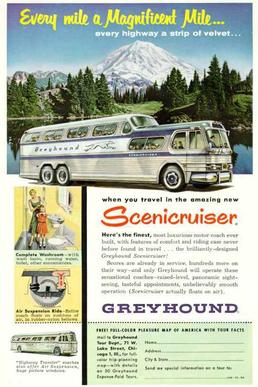| PD-4501 Scenicruiser | |
|---|---|
 Greyhound ad showing a Scenicruiser | |
| Overview | |
| Manufacturer | GMC |
| Production | 1,001 units |
| Assembly | GMC Truck and Coach Division, Pontiac, Michigan |
| Body and chassis | |
| Class | Tri-axle coach |
| Body style | Single-decker (Split level) coach |
| Doors | 1 door, front |
| Floor type | High-floor |
| Powertrain | |
| Engine |
|
| Capacity | 10 on lower level, 33 on upper level. Total 43 seats |
| Transmission |
|
| Dimensions | |
| Length | 40 feet (12.19 m) |
| Width | 96 inches (2,438 mm) |
| Height | 134 inches (3,404 mm) |
| Chronology | |
| Predecessor | GX-2 |
| Successor | GM Buffalo bus |
The GMC PD-4501 Scenicruiser, manufactured by General Motors (GM) for Greyhound Lines, Inc., was a three-axle monocoque two-level coach that Greyhound used from July 1954 into the mid-1970s. 1001 were made between 1954 and 1956.
The Scenicruiser became an icon of the American way of life due to its presence throughout the United States in cities and along highways and popularity with the traveling public. The name was a portmanteau of the words "scenic" and "cruiser".
The high-level design concept of Scenicruiser resembles some of the rolling stock of the passenger-carrying railroads of the United States and Canada, particularly their popular stainless steel dome cars. This type of two-level motorcoach body was common in the late 1940s in Western Europe, including Great Britain, where it was known as Observation coach.[1]
The concept of two-level monocoque body had been used earlier in the Spanish Pegaso Z-403 two-axle coach, designed in 1949 and entered production in 1951.[2]
- ^ "Hargreaves of Bolton: Foden PVSC6 19??: Whitson RC35C". Old Bus Photos. Archived from the original on November 5, 2013. Retrieved March 10, 2013..
- ^ "Pegaso Monocasco (monocoque) brochure 1951". Archived from the original on May 8, 2013. Retrieved March 10, 2013..